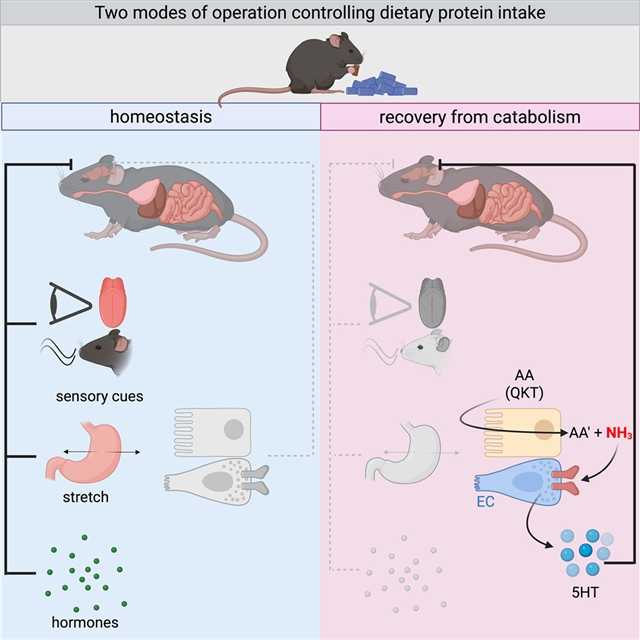
美国耶鲁医学院Andrew Wang团队的研究显示,从分解代谢状态恢复过程中,肠道到大脑的信号限制了膳食蛋白质的摄入。该项研究成果发表在2025年11月4日出版的《细胞》上。
在研究人员努力理解恢复生理学的过程中,团队发现了一个令人惊讶的现象,即小鼠以牺牲热量供应为代价来限制蛋白质的摄入。研究团队在膳食蛋白质中发现了三种氨基酸——谷氨酰胺(Q)、赖氨酸(K)和苏氨酸(T),它们在分解代谢状态恢复过程中对蛋白质厌恶是必要和充分的。QKT的厌食作用由肠道氨作用驱动,肠染色质细胞以TRPA1依赖性的方式感知,并通过血清素信号传导到脑干神经元,诱导厌食。该团队建议这一机制作为对抗氨毒性的第一线防御。总之,该研究团队确定了一组在恢复期间的适应性食物偏好(“恢复行为”),这对理解病理性恢复疾病和开发用于增强恢复的治疗干预措施具有重要意义。
研究人员表示,饮食需求是动态的,营养的最佳范围随时间和生理状态而变化。如何确定最佳营养设定值以及为什么要调整这些设定值在很大程度上仍然未知。
附:英文原文
Title: Gut-to-brain signaling restricts dietary protein intake during recovery from catabolic states
Author: Nikolai P. Jaschke, Joseph R. Luchsinger, Zuojia Chen, Vera C. Wulfmeyer, Xavier de la Rosa, Oliver Hahn, Cuiling Zhang, Nathaniel D. Bachtel, Jaime L. Cullen, Tilman D. Rachner, Ruslan Medzhitov, Markus M. Rinschen, Chuan Wu, Andrew Wang
Issue&Volume: 2025-11-04
Abstract: Dietary needs are dynamic, with optimal ranges for nutrients varying over time and across physiological states. How optimal nutrient set points are established and why they are adjusted remains largely unknown. In our efforts to understand the physiology of recovery, we made the surprising observation that mice restrict protein intake at the expense of caloric supply. We identified three amino acids—glutamine (Q), lysine (K), and threonine (T)—within dietary protein, which are necessary and sufficient for protein aversion during recovery from catabolic states. The anorexigenic effects of QKT are driven by ammoniagenesis in the gut, sensed by enterochromaffin cells in a TRPA1-dependent fashion and transduced to brainstem neurons via serotonin signaling, inducing anorexia. We propose that this mechanism serves as a first-line defense against ammonia toxicity. In summary, we identified a set of adaptive food preferences during recovery (“recovery behavior”), with implications for understanding diseases of pathologic recovery and the development of therapeutic interventions deployed to enhance recovery.
DOI: 10.1016/j.cell.2025.10.005
Source: https://www.cell.com/cell/abstract/S0092-8674(25)01134-1
